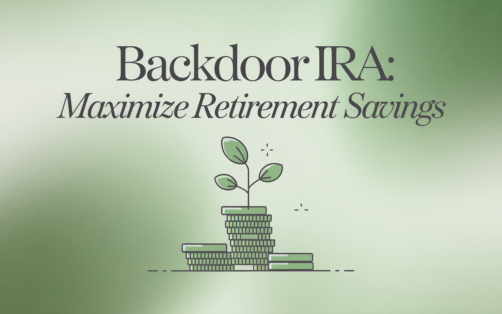Backdoor IRA: Maximize Retirement Savings for Federal Employees
Imagine a retirement where your nest egg not only covers your basic needs but also provides the freedom to pursue your passions. Whether that means enjoying extended time with your grandkids or traveling to places on your bucket list, many federal employees set their hearts on a comfortable, secure retirement. Yet as your income grows—and for federal or military employees nearing retirement, that often happens—contributing directly to a Roth IRA can become restricted. That is where the concept of a backdoor IRA (also called a backdoor Roth IRA) enters the picture.
At PlanWell, our ChFEBC, CFP, and AIF professionals have guided federal employees through retirement planning for decades, using our proprietary Fed-Expert Financial Blueprint. This friendly, professional approach shines a light on strategies like the backdoor Roth IRA, which can be a powerful way to secure future tax-free income if implemented correctly. Below, we will explore what a backdoor IRA is, why it matters for federal employees, and the key steps and considerations to keep in mind.
Understanding the Backdoor IRA: Key Concepts
The term backdoor IRA or back door Roth IRA may sound cryptic, but it is actually straightforward. A Roth IRA typically comes with income limits—if you earn above a certain threshold, you cannot directly contribute. Many federal workers, especially those at higher pay grades or who receive multiple sources of income, find themselves above these limits and assume they have no way to access the benefits of a Roth IRA. In reality, you can make a non-deductible contribution to a traditional IRA and then convert that amount into a Roth IRA (often within a short window). This sequence is what people commonly refer to as a backdoor Roth IRA conversion.
Keep in mind, a Roth IRA offers tax-free growth and withdrawals, whereas a traditional IRA offers tax-deferred growth that may face taxation on future distributions. Since the federal government has clearly defined income thresholds for direct Roth IRA contributions, understanding—and using—the backdoor IRA strategy ensures high-income earners do not miss out on valuable Roth advantages.
2023 Roth IRA Income Limits
| Filing Status | Phase-Out Range (MAGI) | Ineligible Above (MAGI) |
|---|---|---|
| Single Filers | $150,000 – $165,000 | Above $165,000 |
| Married Filing Jointly | $236,000 – $246,000 | Above $246,000 |
As you can see above, the window to contribute directly to a Roth IRA closes quickly for high earners, which is why a backdoor IRA can be so significant. Because the contribution begins in a traditional IRA—where no income cap applies—and then moves into a Roth IRA, you effectively bypass the original Roth IRA income restrictions.
Why Backdoor IRA Is Especially Relevant for Federal Employees
Federal employees often enjoy stable salaries that can inch them beyond these Roth IRA income thresholds over the course of their career. In addition, many of you have already built a sound retirement framework through the Federal Employees Retirement System (FERS), the Thrift Savings Plan (TSP), and possibly a military pension. You might assume there is little need for an additional retirement account. Yet a Roth IRA—via a back door IRA strategy—brings distinct benefits many federal retirement options do not. For instance, Roth IRAs generally have no required minimum distributions (RMDs) during your lifetime. In contrast, TSP and traditional IRAs do impose RMDs starting at age 73. Eliminating those forced distributions can mean more control over when and how you take retirement income.
Furthermore, if you ever worry about your Social Security benefits getting taxed, balancing your tax-deferred and tax-free income streams can help minimize that strain. While the TSP does have a Roth version, many federal employees who started saving decades ago have primarily been in the traditional TSP. The backdoor Roth IRA can supplement or diversify what you already have in your TSP, providing the possibility for flexible, tax-free retirement income when you need it most. (Roth TSP vs Traditional TSP)
Sometimes, you might hear about a TSP Roth conversion. This is an option for some employees, but the TSP does not always allow “in-plan” conversions as freely as many private 401(k) plans do. The backdoor Roth approach remains a more consistent, widely available strategy for all federal employees—no matter where you are stationed or which agency you serve.
Step-by-Step Guide to Executing a Backdoor IRA
For a back door IRA, the main steps are conceptually simple. However, it is important to follow them carefully to avoid errors or extra taxes. First, open both a traditional IRA and a Roth IRA. If you already own these accounts, ensure you track any pre-tax versus after-tax dollars properly. Next, make a non-deductible contribution to your traditional IRA, which means you will be contributing money that has already been taxed. Finally, initiate a roth ira backdoor conversion by moving those funds from the traditional IRA into the Roth IRA. You will report your non-deductible contribution and subsequent Roth conversion on IRS Form 8606.
Contribution Limits by Age
| Age Group | Traditional IRA Limit | Roth IRA Limit | Combined Backdoor Strategy? |
|---|---|---|---|
| Under 50 | $7,000 | $7,000 | Yes |
| 50 and Older | $8,000 | $8,000 | Yes (catch-up) |
Note that these contribution limits apply individually. When practicing a backdoor Roth IRA conversion, the maximum you can move each year generally tracks these amounts. For some federal employees who have missed out on years of Roth contributions due to high income, this strategy becomes especially appealing.
Pro-Rata Rule & Other Tax Considerations
One of the more complicated aspects of a backdoor Roth IRA conversion for federal employees is the pro-rata rule. In simple terms, the IRS expects you to treat all your IRAs as a single entity when determining how much of your conversion is taxable. If your traditional IRA balances include pre-tax funds from prior years, a portion of your conversion might be taxable even if this year’s contribution is after-tax.
Pro-Rata Rule Example
| Existing Pre-Tax IRA | New After-Tax Contribution | Percentage of After-Tax Funds | Taxable Portion of Conversion |
|---|---|---|---|
| $50,000 | $5,000 | 10% | ≈90% of converted amount |
In the above example, because of that $50,000 of pre-tax dollars sitting in your traditional IRA, only about 10% of your $5,000 conversion will come out tax-free in the year you convert, assuming no additional offsets. However, many federal employees can avoid this entirely by rolling existing pre-tax IRA balances into the TSP before executing a backdoor IRA. Since TSP does not count in the pro-rata calculation, your IRA would no longer hold much (or any) pre-tax money. In short, the cleaner your IRAs are before conversion, the less you owe in taxes.
Also be mindful of the “five-year rule,” which generally means you need to keep converted funds in the Roth IRA for at least five years if you are under age 59½ to avoid certain penalties. While not a concern for everyone, you should confirm that your plans to withdraw funds do not trigger additional taxes.
Strategies for Federal Employees to Optimize the Backdoor IRA
Because you have unique federal benefits, you will want to approach the backdoor IRA with a holistic lens. One popular tactic is to consolidate any existing pre-tax IRA balances into your TSP. By transferring that money into TSP, you remove the pre-tax funds from the backdoor Roth IRA equation. This step alone reduces or eliminates the complexities of the pro-rata rule.
Another consideration is timing. Some do a backdoor Roth IRA conversion early in the year, which can help maximize the time for potential tax-free growth. Others coordinate conversions to keep their total income in a certain bracket. Either way, it is wise to work with someone who understands both traditional tax strategies and federal benefits, ensuring your FERS pension, TSP contributions, and other benefits coordinate smoothly. At PlanWell, our Fed-Expert Financial Blueprint is designed to account for these overlapping components, allowing federal employees or retirees to establish a confident path forward.
If you would like more immediate guidance on timing and how to integrate a backdoor Roth IRA into a robust TSP strategy, you are welcome to sign up for one of our free Federal Retirement Planning Workshops. We hold these sessions regularly and tailor them specifically to the unique financial circumstances of government employees.
Comparison: Backdoor IRA vs. Other Federal Retirement Options
A backdoor Roth IRA should seldom exist in a vacuum. It is one piece of a broader puzzle that includes FERS pensions, TSP accounts (traditional or Roth), and even Social Security timing. Each retirement vehicle has a particular tax treatment and set of rules regarding distributions. Having a high-income during your working years also means your decisions on how to structure your retirement accounts can affect your tax bill—both now and into retirement.
Key Differences at a Glance
| Retirement Account | Tax Treatment | RMD Requirements | Contribution Limits | Ideal For |
|---|---|---|---|---|
| TSP | Pre-tax or Roth TSP | Yes (at age 73+) | $23,500 (under 50 in 2025) | Federal employees wanting a low-cost, stable plan |
| Traditional IRA | Pre-tax or after-tax | Yes (starting at age 73) | $7,000 (under 50 in 2025) | General retirement savings |
| Roth IRA | After-tax, tax-free growth | No RMD | $7,000 (subject to income limits) | Individuals seeking tax-free retirement income |
| Backdoor Roth IRA | After-tax conversion | No RMD | $7,000 if under 50 (can circumvent income limits) | High-income earners wanting Roth benefits |
*Contribution limits typically adjust annually.
As you can see, a backdoor roth ira conversion is aimed at folks who exceed direct Roth IRA income limits yet still crave those tax-free distributions later in life. For many federal workers, especially those above 55, adding a Roth component to your portfolio can offer meaningful flexibility in how you choose to draw your retirement income.
Action Steps & Next-Level Guidance
Implementing a back door IRA should not feel like an exercise in frustration. Start with checking if you exceed current Roth IRA income limits. If you do, decide whether rolling pre-tax IRA funds into TSP is an option. Next, ensure you handle every step of the conversion methodically: making the non-deductible contribution, converting, and reporting properly on IRS Form 8606. If your adjusted gross income creeps higher each year (for instance, if you plan to work beyond your initial FERS eligibility), conduct an annual review to maintain compliance and avoid any unwanted surprises at tax time.
Of course, if you want a deeper dive into how this strategy fits into your broader plan, you are welcome to sign up for one of our free Federal Retirement Planning Workshops. Here, we detail strategies for TSP Roth conversion, FERS synergy, and how to build a retirement roadmap that protects your lifestyle and legacy. We also showcase PlanWell’s Fed-Expert Financial Blueprint, which customizes solutions for your unique situation.
Conclusion
For many federal and military employees who exceed direct Roth IRA income limits, the backdoor IRA stands as a valuable strategy to gain access to a Roth’s tax-free growth and withdrawal benefits. By understanding how to navigate conversion rules—and by addressing potential tax hurdles like the pro-rata rule—federal employees can position themselves for a more flexible and potentially lower-tax retirement. Pairing a backdoor Roth IRA with traditional retirement pillars like the TSP and a FERS pension can ensure a balanced blend of both tax-deferred and tax-free income.
At PlanWell, we combine decades of experience with our specialized ChFEBC, CFP, and AIF knowledge to guide federal employees through every stage of retirement planning. If you are curious about refining your own plan, do not hesitate to reach out or sign up for one of our free Federal Retirement Planning Workshops. It may well be your first step toward a stronger, more confident retirement future.










